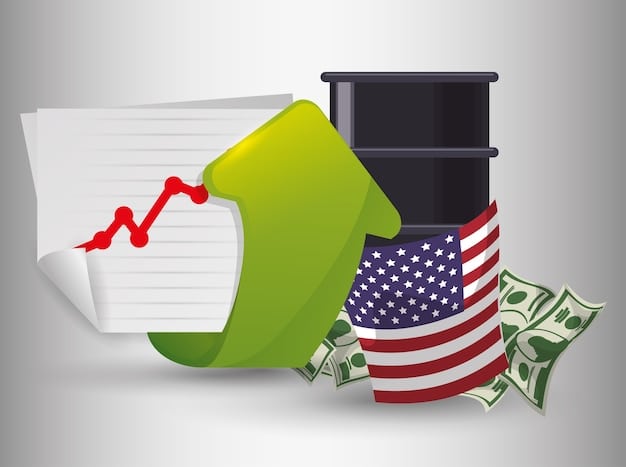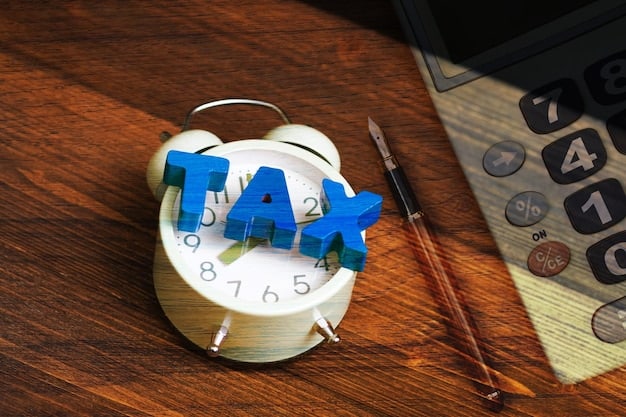Federal Tax Overhaul 2025: Latest Updates & What It Means for You

Anúncios
What’s the Latest on the Proposed Federal Tax Overhaul for 2025? Tax overhaul discussions are ongoing, with potential changes impacting individual income taxes, corporate taxes, and estate taxes, but the specifics remain under debate as lawmakers consider various proposals and their economic effects.
Anúncios
Navigating the complexities of federal tax laws can be daunting, especially when significant overhauls are on the horizon. Staying informed about What’s the Latest on the Proposed Federal Tax Overhaul for 2025? is crucial for individuals and businesses alike, allowing for proactive financial planning and minimizing potential disruptions.
Understanding the Impetus Behind the 2025 Tax Overhaul
The potential for a significant federal tax overhaul in 2025 stems from the scheduled expiration of key provisions of the Tax Cuts and Jobs Act (TCJA) of 2017. This legislation introduced numerous changes to individual and corporate tax rates, deductions, and credits, many of which are set to sunset at the end of 2025. Understanding the original intent and provisions of the TCJA is essential to grasp the potential scope and impact of the upcoming overhaul.
Anúncios
As 2025 approaches, policymakers face the challenge of deciding which TCJA provisions to extend, modify, or allow to expire. These decisions will have far-reaching consequences for taxpayers and the economy as a whole. Let’s delve into what led us here.
The Core of the Tax Cuts and Jobs Act (TCJA)
The TCJA, enacted in late 2017, represented a significant departure from previous tax policy. It reduced the top corporate tax rate from 35% to 21%, implemented changes to individual income tax brackets, and introduced a new deduction for qualified business income (QBI) for pass-through entities. These changes were intended to stimulate economic growth by incentivizing investment and job creation.
Why TCJA Provisions Are Set to Expire
Many of the TCJA’s individual tax provisions were designed to be temporary, with an expiration date set for December 31, 2025. This sunset provision was included to comply with budget reconciliation rules in the Senate, which require that tax cuts enacted through this process be temporary unless offset by other revenue increases or spending cuts. The expiration of these provisions is the primary driver behind the current discussion of a federal tax overhaul.

In summary, the upcoming tax overhaul is largely driven by the expiring provisions of the TCJA. The decisions made by policymakers regarding these expiring provisions will shape the future of federal tax law and have significant implications for taxpayers across the country.
Potential Scenarios for the 2025 Tax Overhaul
Given the complexity of the issues and the diverse perspectives of policymakers, several potential scenarios for the 2025 tax overhaul have emerged. These scenarios range from extending the TCJA provisions as they are to enacting a comprehensive reform of the tax code. Each scenario would have different implications for individuals, businesses, and the economy.
Let’s explore some of the main paths being considered.
Extending the TCJA Provisions
One possibility is that Congress could choose to extend the TCJA provisions largely as they are, either permanently or for a specified period. This approach would provide certainty for taxpayers and businesses, but it would also add significantly to the national debt. This is certainly the path some favor.
Modifying the TCJA Provisions
Another scenario involves modifying the TCJA provisions, either by making some of them permanent while allowing others to expire, or by adjusting the rates, deductions, and credits within the existing framework. This approach could be seen as a compromise between those who want to maintain the TCJA’s tax cuts and those who are concerned about the fiscal impact.
Comprehensive Tax Reform
A more ambitious scenario would involve a comprehensive reform of the tax code, addressing issues such as tax simplification, base broadening, and revenue neutrality. This approach could result in significant changes to the tax system, with both winners and losers depending on the specific details of the legislation.
- Economic Growth: Proposals aim to spur investment and job creation.
- Fiscal Impact: Decisions will significantly affect the national debt.
- Taxpayer Equity: Reform could address fairness and simplicity in the tax code.
In conclusion, the potential scenarios for the 2025 tax overhaul are diverse, each with its own set of economic and political considerations. The ultimate outcome will depend on the ability of policymakers to reach a consensus on the future direction of federal tax policy.
Key Areas of Potential Change in the 2025 Tax Overhaul
The 2025 tax overhaul could affect various aspects of the federal tax system, including individual income taxes, corporate taxes, and estate taxes. Understanding these key areas of potential change is crucial for taxpayers to anticipate and prepare for the upcoming reform.
Let’s consider each of these in turn.
Individual Income Taxes
The individual income tax provisions of the TCJA, such as the reduced tax rates, increased standard deduction, and limitations on itemized deductions, are all scheduled to expire at the end of 2025. The 2025 tax overhaul could involve extending, modifying, or allowing these provisions to expire, which would have a direct impact on individual taxpayers’ tax liabilities.
Corporate Taxes
While the TCJA’s reduction of the corporate tax rate from 35% to 21% is permanent, other corporate tax provisions, such as the rules for deducting business expenses and the treatment of foreign income, could be subject to change in the 2025 tax overhaul. These changes could affect businesses’ profitability and investment decisions.
Estate Taxes
The TCJA doubled the estate tax exemption, but this provision is also scheduled to sunset at the end of 2025. The 2025 tax overhaul could involve extending, modifying, or allowing this provision to expire, which would affect the taxation of large estates.

In short, the 2025 tax overhaul could bring about significant changes to individual income taxes, corporate taxes, and estate taxes. Taxpayers should pay close attention to these potential changes and consult with a tax professional to understand how they may be affected.
The Role of Economic Factors in Shaping the Tax Overhaul
Economic conditions and forecasts will play a significant role in shaping the 2025 tax overhaul. Policymakers will consider the impact of potential tax changes on economic growth, inflation, and the national debt when making decisions about the future of federal tax law.
Assessing the current economic context is crucial.
Impact on Economic Growth
Advocates for extending the TCJA’s tax cuts argue that they stimulate economic growth by incentivizing investment and job creation. Opponents, on the other hand, contend that the tax cuts disproportionately benefit the wealthy and do little to boost long-term economic growth. Policymakers will need to weigh these competing arguments when considering the economic impact of the tax overhaul.
Impact on Inflation
With inflation remaining a concern, policymakers will also need to consider the potential impact of tax changes on price levels. Some economists argue that tax cuts could exacerbate inflationary pressures by increasing demand, while others maintain that they could help to boost supply and ease inflation. The right path isn’t clear.
Impact on the National Debt
The national debt is another key economic factor that will influence the 2025 tax overhaul. Extending the TCJA’s tax cuts without offsetting revenue increases or spending cuts would add significantly to the debt, which could have negative long-term consequences for the economy. Policymakers will need to strike a balance between tax cuts and fiscal responsibility.
- GDP Growth: Tax changes can influence the pace of economic expansion.
- Inflation Rates: Policies may exacerbate or alleviate price pressures.
- Debt Levels: Decisions must account for long-term fiscal sustainability.
To conclude, the 2025 tax overhaul will be shaped by a variety of economic factors, including the impact on economic growth, inflation, and the national debt. Policymakers will need to carefully consider these factors when making decisions about the future of federal tax policy.
Navigating the Political Landscape of the 2025 Tax Overhaul
The 2025 tax overhaul is not only an economic issue but also a political one. The outcome of the reform will depend on the balance of power in Congress and the White House, as well as the ability of policymakers to bridge partisan divides and reach a compromise.
Understanding the positions of key stakeholders is essential.
Party Positions
The Democratic and Republican parties have traditionally held divergent views on tax policy, with Democrats generally favoring higher taxes on the wealthy and corporations to fund social programs and reduce income inequality, while Republicans tend to support lower taxes across the board to stimulate economic growth.
Stakeholder Interests
Various stakeholder groups, including businesses, labor unions, and advocacy organizations, will also seek to influence the 2025 tax overhaul. These groups will lobby policymakers to advance their interests, which can further complicate the political landscape.
Potential for Compromise
Given the divergent views and competing interests, reaching a compromise on the 2025 tax overhaul will likely be a challenging task. However, there may be areas where common ground can be found, such as simplifying the tax code or addressing specific tax loopholes. The ultimate outcome will depend on the willingness of policymakers to engage in good-faith negotiations.
In conclusion, the political landscape of the 2025 tax overhaul is complex and multifaceted. The outcome will depend on the interplay of party positions, stakeholder interests, and the potential for compromise. Observers should stay informed about the political dynamics and the positions of key players to understand the likely direction of the reform.
Strategies for Taxpayers to Prepare for the 2025 Changes
Given the uncertainty surrounding the 2025 tax overhaul, taxpayers should take proactive steps to prepare for potential changes. This includes understanding the current tax law, reviewing their financial situation, and consulting with a tax professional.
Here are some tactical steps taxpayers can take.
Understand Current Tax Law
Before preparing for future changes, taxpayers should have a solid understanding of the current tax law, including the TCJA provisions that are set to expire. This will allow them to better assess the potential impact of the 2025 tax overhaul on their tax liabilities.
Review Financial Situation
Taxpayers should review their financial situation, including their income, deductions, and credits, to identify areas where they may be affected by the tax overhaul. This will help them to develop a plan to mitigate any negative consequences.
Consult with a Tax Professional
Given the complexity of the tax law, taxpayers should consider consulting with a tax professional to get personalized advice and guidance. A tax professional can help them to understand the potential impact of the tax overhaul on their specific situation and develop strategies to minimize their tax liabilities.
- Track Proposals: Follow legislative updates to stay informed on potential changes.
- Adjust Withholding: Modify tax withholding to align with anticipated tax liabilities.
- Plan Strategically: Consult professionals to optimize tax planning for 2025.
In conclusion, preparing for the 2025 tax overhaul requires a proactive approach. Taxpayers should understand the current tax law, review their financial situation, and consult with a tax professional to develop strategies to navigate the upcoming changes.
| Key Aspect | Brief Description |
|---|---|
| 📅 TCJA Expiration | Several provisions from the 2017 Tax Cuts and Jobs Act are expiring at the end of 2025, necessitating a tax overhaul. |
| ⚖️ Potential Scenarios | Options include extending the TCJA, modifying it, or enacting comprehensive tax reform. |
| 💰 Areas of Change | Changes may occur in individual income taxes, corporate taxes, and estate taxes. |
| 📈 Economic Factors | Economic growth, inflation, and national debt will all influence tax overhaul decisions. |
Frequently Asked Questions (FAQ)
▼
A tax overhaul refers to significant changes to a country’s tax system, including altering tax rates, deductions, and who pays what. It aims to reform the system, often seeking to simplify it, make it fairer, or stimulate economic activity.
▼
It is important because several key provisions of the 2017 Tax Cuts and Jobs Act (TCJA) are expiring at the end of 2025. This necessitates decisions about extending, modifying, or replacing these provisions, which will significantly affect individuals and businesses.
▼
The overhaul could affect individual income taxes through changes to tax rates, standard deductions, and itemized deductions. It can also influence estate taxes, potentially affecting those with large estates as well as impacting investment and savings strategies.
▼
Economic factors like GDP growth, inflation, and national debt all play a crucial role. Lawmakers will consider these when deciding tax policy, to balance spurring economic activity with maintaining fiscal responsibility. All of these issues are important points.
▼
Taxpayers can prepare by staying informed on legislative updates, reviewing their financial situation, and consulting a tax professional. This proactive approach can help them anticipate and adapt to potential changes, making proper adjustments proactively.
Conclusion
In conclusion, the proposed federal tax overhaul for 2025 presents a complex landscape of potential changes and impacts. Staying informed, understanding the potential scenarios, and preparing proactively are key for taxpayers to navigate the upcoming reform effectively.